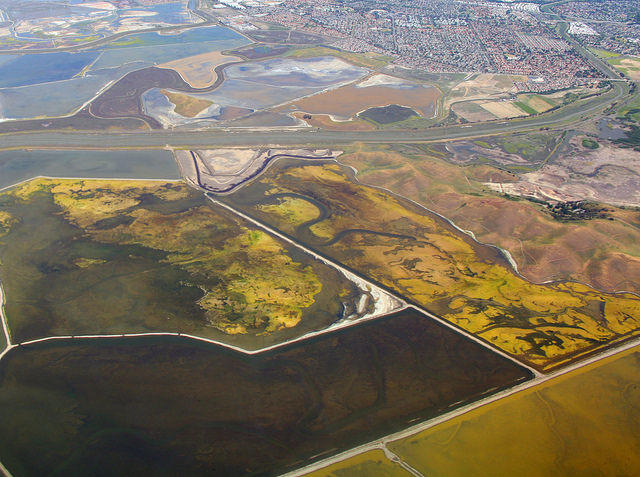Latest News and Updates from Audubon in California
California Condor. Photo: Scott Frier/USFWS

Much like our own Sonoma Creek Marsh restoration project, our colleagues at Santa Clara Audubon Society are bringing back a formerly troubled area of San Francisco Bay. They are one of several groups involved with the South Bay Salt Pond Restoration Project, the largest tidal wetland restoration project on the West Coast. The restoration is converting 15,100 acres of commercial salt ponds at the South end of San Francisco Bay to a mix of tidal marsh, mudflat and other wetland habitats. The San Jose Mercury News reports that a focal species has already arrived on the restoration site:
"We're ecstatic. It's a milestone," said biologist Rachel Tertes of the U.S. Fish and Wildlife Service, who on Sunday led a small private tour along the dusty levee of the pond, which is closed to the public.
"It happened so quickly," said Tertes, a member of the team at Don Edwards San Francisco Bay National Wildlife Refuge that found both species only nine years after excavators breached the walls of the toxic pond, allowing natural tidal flows to resume.
The morning sun was just rising over the bay last July when Tertes and a team of wildlife surveyors were suddenly startled by the clattering sound of a pair of Clapper, now called Ridgway's, Rails.
"It was a duet. Male and female, dueling clatters," said Tertes. "It blew everyone's mind."
Read the rest of the article by clicking here.
To read more about the project, click here.
The Los Angeles Times reports:
After four parched years, most California voters seem to be taking the drought in stride, saying it has had little to no effect on their daily lives. They oppose sacrificing environmental protections to expand water supplies and generally approve of how Gov. Jerry Brown has handled the crisis, according to a new statewide USC Dornsife/Los Angeles Times poll...
Given a choice between protecting the environment at the expense of water supply or ensuring water supply even if that damages the environment, 50% of those polled favored the environment and 34% picked water supply.
Continue reading the entire article here.
Assembly Bill 1482, establishing a Strategic Growth Council that will oversee climate adaptation for critical habitat, passed out of the Senate yesterday. The bill would require state agencies to consider climate adaptation strategy when making decisions. Audubon California co-sponsored the bill with Assembly Member Rich Gordon.
Birds on the brink get the Steadman treatment. Illustrator Ralph Steadman -- yes, that Ralph Steadman -- has a new book coming out featuring his illustrations of birds on the brink of extinction. The book is called Nextinction. The above image is his take on the Laysan Duck.
Legislation that will make it state policy to protect wildlife corridors passed out of the State Senate Friday and is on its way to Gov. Jerry Brown’s desk for his signature. Assembly Bill 498, co-sponsored by Audubon California and authored by Assembly Member Marc Levine, will help birds by protecting vital linkages between important habitat areas. These protections will also give birds a better chance of surviving the challenges of climate change, as many of these corridors are also habitat strongholds or connect strongholds that birds and other wildlife need to survive in an environment altered by climate change.
“As we learn more about the habitats that will serve as strongholds for birds and other wildlife in California, it is vital that we also identify ways to connect them,” said Mike Lynes, Audubon California’s director of public policy. “Not only will Assembly Bill 498 help California protect its most vital landscapes, but it will also ensure that we make the best conservation investments as well.”
Assembly Bill 498 will make it a policy of the state that, whenever a project is proposed in an area defined as a wildlife corridor, the proponent will be encouraged to work with the Department of Fish and Wildlife to ensure the continued functioning of that corridor.
According to a study released in September 2014 by the National Audubon Society, 170 California bird species will be at risk of extinction in the next several decades due to global warming. This legislative session, Audubon California is supporting proposed bills that reduce the carbon pollution that causes climate change, and bills that will help birds survive in a new environment.
Our congratulations to the Marin Audubon Society for finalizing the purchase of 5.2 acres of former tidal marsh proptery in Corte Madera this week. The Audubon chapter raised more than $1 million to finalize the purchase. According to Barbara Salzman, president of Marin Audubon, the next step is to conduct a full restoration of the marsh, after which the property will be donated to the State Department of Fish and Wildlife for long-term protection as part of the Corte Madera Ecological Reserve. Audubon California was able to help this project with funding from the Wimberly Foundation.
Our newsletter is fun way to get our latest stories and important conservation updates from across the state.
Help secure the future for birds at risk from climate change, habitat loss and other threats. Your support will power our science, education, advocacy and on-the-ground conservation efforts.
Join the thousands of Californians that support the proposed Chuckwalla National Monument.